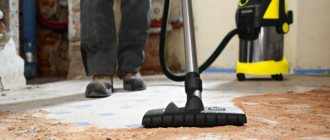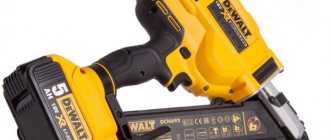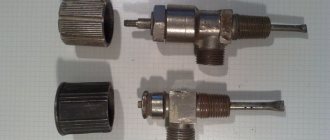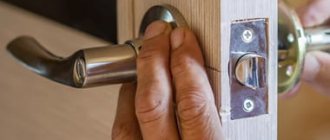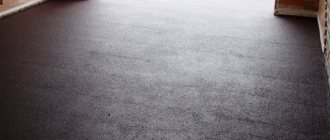Peculiarities
Polyurethane foam is required when installing door frames, plastic windows and for other purposes. If you apply it manually, many problems arise, so it is better to purchase a special gun for it. Modern manufacturers of construction equipment offer a wide variety of guns for using polyurethane foam. They differ in appearance and are presented in various designs.
Foam cylinders come in a huge range: if you buy a high-quality application tool, it will fit any cylinder. A spray foam gun is an easy-to-use tool, but you shouldn’t take it lightly. Before using it, you should take measures for your own safety. It is recommended to use the tool only with safety glasses and special gloves.
Rules for using professional polyurethane foam sealant
How to prepare the surface
In order to reliably seal, it is necessary to properly prepare the surface.
To do this you should:
- Clean the surface from dust and dirt.
- Thoroughly wet the hole or crack with water from a spray bottle.
Recommendations for correct and safe use
- If polyurethane foam is used, be sure to moisten the sealing area with water.
- The foam should be used at ambient temperatures from +5 to +20 degrees.
- If sealing is required at subzero air temperatures, then it is necessary to use special frost-resistant polyurethane foam.
- Carry out sealing work wearing rubber gloves and safety glasses.
Technique for using a can of sealant
- When performing installation work on sealing, without using a gun, a PVC tube is used, which is equipped with a “household” and sometimes “professional” foam cylinder.
- The tube is installed on the cylinder valve.
- The end of the tube is placed in the hole, which needs to be filled with polyurethane foam mixture.
- By pressing the valve, the sealant flows through the tube directly into the hole.
- When hardening, polyurethane foam expands significantly and can extend beyond the crack or hole being sealed, so the cavity is not completely filled with the mixture, leaving some space for the foam to increase in volume after drying.
- Frozen excess is removed with a stationery knife half an hour after sealing.
Tool maintenance after work
If sealing work is carried out from a cylinder with polyurethane foam, without a gun. Then, after a single use, even if all the material is not completely used up, the cylinder is thrown away, since due to the frozen foam inside the valve and tube, further use is not possible.
But, you can use the folk method of maintaining the functionality of the valve mechanism.
Drying of the foam inside the valve and tube will not occur if air access to this mechanism is reliably blocked.
Therefore, it is enough to insert an object slightly larger in diameter than the hole into a tube completely filled with foam.
Important! The tube must be completely filled with polyurethane foam until there is an object that prevents it from flowing out.
After the tube is sealed, the cylinder is stored in a dark, cool room.
If it becomes necessary to use polyurethane foam, re-preservation occurs by cutting off the section of the tube where there is an object that blocks the hole.
If the cylinder was contaminated during work, it should be wiped with a solvent, and care must be taken not to allow the solvent to come into contact with plastic parts.
Advantages
The need to purchase a spray foam gun is due to its advantages.
- provides the ability to accurately dose the material during use;
- provides high-quality sealing and excellent thermal insulation of seams;
- provides economical consumption of polyurethane foam; allows the use of cylinders with sealant, even if it has already been used, and a lot of time has passed, since it prevents the foam from hardening in the supply system.
Application area
The sealant has eclipsed many of its predecessors - plaster, mineral wool tapes, cement, bitumen, etc., which is no wonder.
It is used for:
- installation of door and window blocks;
- fastening insulation, waterproofing, sound insulation;
- filling cracks and crevices formed during repairs;
- filling voids that appeared during construction;
- performing facing works;
- filling holes, cracks, cracks in interior items.
The substance has a wide range of applications. Because of this, it will definitely not be forgotten, somewhere on a dusty shelf in the garage or closet.
Types of pistols
Modern manufacturers of construction equipment offer a wide range of guns for working with polyurethane foam. To choose the right tool, you should familiarize yourself with its varieties. The material of the device is of great importance. Plastic models are the most accessible because they are cheap. Manufacturers do not use metal parts, so they are not durable.
Such options quickly break or become clogged with installation compounds. If a plastic gun stops working, you should buy a new one as it cannot be repaired. Often, when purchasing a plastic gun, they sell several more tubes in the kit for replacement. It should be understood that it is non-separable. Even with a strong desire to clean it, you will not be able to disassemble it.
The plastic tool is durable to use. Basically, this option is the most convenient for doing a small amount of work. It is purchased by those who do not like to clean the tool after use. A good alternative to a plastic gun is a regular plastic tube that is attached to a can of polyurethane foam. The result is the same, only the tube costs less. The difference is that the balloon fits differently in your hand.
Guns for polyurethane foam made of metal are of good quality and are reusable. They can be disassembled and cleaned after use. If any kind of breakdown occurs, they can be repaired. A high-quality model will last for several years if handled carefully. This option is chosen by many professionals who understand that high-quality tools play a big role when performing construction work. It allows you to get the job done efficiently.
It is worth paying attention to combined models , which are made of plastic and metal. The pistol barrel is made of metal, and the remaining parts (body, handle, trigger and adapter) are made of plastic. Combination tools are lightweight and can withstand impacts. If you drop a plastic gun from the ceiling, it is unlikely to work.
When choosing a combined model, you need to make sure that it is collapsible. If the gun cannot be disassembled, it is not worth paying a lot of money for it; you can immediately buy the plastic version, because they will last the same. The best ones are those with Teflon coating. They are characterized by excellent quality, are practically not prone to breakdowns, have a long service life and are easy to clean. Their only drawback is their high cost.
Benefits of use
The mounting guns have a well-thought-out and ergonomic design. First of all, they are equipped with a comfortable handle for holding during work and are lightweight. The combination of these factors allows you to move freely and eliminates serious strain on your hands, which would make it inconvenient to carry out work. Other advantages of use include the following factors:
- precision during application - the long tip of the gun allows you to penetrate deep joints and holes, ensuring high-quality application strictly in the right areas and obtaining a foam layer of uniform thickness;
- dosed supply - a nozzle with a variable size allows you to distribute the material strictly in the required volume, which allows you to further eliminate the deformation of structures due to secondary expansion of the composition;
- optimal speed of foam release - adjustable speed of foam release allows you to work with greater comfort, adjusting the tool to your own pace;
- ease of processing difficult areas - when using cylinders with a plastic tube, a big problem is foaming areas under the ceiling or with other natural obstacles. When working with the gun, you can forget about this; it allows you to easily reach any hard-to-reach places thanks to the long nose;
- high work productivity - a convenient supply adjustment system allows for faster installation, and a simple system for replacing cylinders also contributes to this.
A mounting gun is an excellent solution for those cases when you need to work quickly and at the same time efficiently. The tool is convenient and easy to use, indispensable for the home workshop or professional use.
Tool structure
Foam guns have a simple design. Even expensive models that have a huge number of parts work using a simple mechanism. Pistols differ in appearance and content, but they all have the same basic parts.
The main elements of a spray foam gun include:
- tool body (base of the product);
- handle for ease of use;
- barrel (used to supply material);
- nozzle (tip of the barrel, helps the foam “shoot”);
- a needle rod or locking needle located inside the barrel;
- ball gear or adapter (for attaching the cylinder, consists of a small spring and a ball, requires special care when washing);
- trigger (responsible for opening the valve);
- adjusting screw (provides fixation of the needle, adjusts the feed speed and amount of material).
- screw with gasket (to protect the trigger from leaking foam).
If the screw is tightened, the foam supply is completely blocked. If the screw is screwed in loosely, the foam flows out quite easily.
Instructions for use
The spray foam gun is easy to use. It is designed for operational work. To use the gun correctly, you should follow a few simple rules, which are based on the characteristics of the tool itself and the cylinder. The foam container should be shaken well before use. It is enough to perform this action for 30 seconds. If work with sealant is carried out outside in frosty weather, the container must be warmed up before use or wait until it warms up at room temperature.
Safety precautions
First of all , you should remember about safety precautions when working with polyurethane foam.
- Never point a gun with a connected cylinder at a person or animal. Contact with the eyes can cause serious injury; in addition, the foam is very difficult to wash off the skin and almost impossible to remove from clothing.
- Despite the apparent simplicity of the gun, it is designed to work with a vessel under pressure (a foam container). Therefore, do not forget about the effects of high temperature. Do not operate the gun near an open flame or under a heat gun. Even a cylinder screwed onto a gun (brought in from the cold) should be heated in water with a temperature of no more than 30 degrees.
How to charge?
To use the gun, you must install it correctly:
- the cylinder must be placed on a flat surface;
- remove the protective cap from the sealant;
- it is necessary to put a tool on it, and the gun should be inserted from above;
- one of the other needs to hold the gun by the handle, and the other needs to rotate the container with sealant until it stops;
- it is necessary to turn the tool with the handle down and the cylinder up to give it a working position;
- you need to turn the adjusting screw about a quarter turn and lightly pull the trigger;
- when the foam fills the entire barrel, the gun is ready for use;
The gun kit is additionally equipped with a tube, which is used to fill seams in hard-to-reach places.
Installing the cylinder on the gun
To learn how to properly use a spray foam gun, you need to move on to practical work, starting with charging it:
- The container is closed on top with a protective cap, which must be removed before installation. The gun is positioned with the handle down and the cylinder is screwed to the adapter in a vertical position. During connection, hold the gun firmly by the handle with one hand, and with the other hand, screw the cylinder onto the adapter with rotational movements.
- After connecting, the contents of the container must be shaken well. This process brings the polyurethane foam substance to a homogeneous composition. The container mounted on the gun is held firmly with your hand and shaken sharply from top to bottom about twenty times. When shaking, the handle should only be at the top.
- After shaking, the device is moved with the container up and the handle down. This is his working position. Turn the adjusting screw a quarter turn and try to pull the trigger. After filling the entire barrel with foam, the tool is ready for use.
Read also: Angle attachment for screwdriver
During operation, it may be necessary to adjust the mixture supply. This can be done by turning the same adjusting bolt.
The working position of the gun is with the cylinder up
How to work?
First you need to prepare the seam. It is enough to moisten it with water. These actions will improve adhesion.
Then you can start working.
- You need to point the tip of the tool at the seam.
- It is necessary to gently pull the trigger of the tool to adjust how much force must be applied to obtain the required foam flow.
- If it is weak, you need to slightly tighten the adjustment screw, which is located at the back of the tool.
- The seam should be filled exclusively from the bottom up, performing zigzag movements.
- The seam should not be complete, since over time the foam tends to expand in volume. If any voids remain in the future, they can be filled with an additional layer (cutting off excess sealant will take more time).
- When working with a long seam, the foam may change its consistency over time, so you should stop and shake the can vigorously again.
- When stopping operation, the tool nozzle must be cleaned of foam using a cloth soaked in solvent or special wipes. After completing the work, be sure to tighten the adjusting screw.
Rules for working with polyurethane foam
Working with foam is quite simple. The main thing is to follow the detailed instructions:
- Wear gloves on your hands to prevent the sealant from getting on your skin, as it is difficult to remove.
- The place where the sealant will be placed is first carefully cleared of debris and dust. When the gap is large in depth and width, it is first filled with small pieces of foam.
- Shake the container as recommended in the instructions, usually 30–60 seconds. Thanks to this, the composition becomes homogeneous and comes out better, which simplifies the work several times.
- The planes inside the recess are wetted, but moderately; water should not flow along the walls.
- The cap is removed from the cylinder, which limits its operation unnecessarily. A tube is put on the ledge, replacing the gun.
- The free edge of the plastic tube is brought to the hole at a distance of 5 cm, now you should press the valve. The hole is filled halfway or a little less, since the volume increases as it dries.
- After 30 minutes, you should carefully inspect the foaming area. If pits or empty cavities are visible, solution should be added.
Before foaming the gap, you need to make sure that the ambient temperature complies with the recommendations in the instructions for the sealant. It is necessary to carry out work when the ambient air temperature is within 5–20 degrees Celsius.
Before foaming the gap, you need to make sure that the ambient temperature complies with the recommendations in the instructions for the sealant.
When applying, you need to constantly adjust the pressure so that it is uniform and the contents come out of the container in equal parts. If it gets on any surface, the composition is poorly cleaned, and there is a risk of damage to the coating. When applied to the desired areas, it must be given time to harden, only then cut off the excess. The composition contains toxic components, so the work area must be thoroughly ventilated.
Complete hardening of the composition occurs after 8 hours. There is no need to worry if swelling has formed at the treatment site - they can be easily cut off with a stationery knife.
How to remove foam from floors or walls where it shouldn’t be? After hardening, this can be done using acetone.
As a precaution, you should protect your eyes by wearing clear glasses. To protect your hands, gloves are suitable, because the composition has excellent adhesion to the skin of the hands.
Removing it will be painful and traumatic.
When applying, you need to constantly adjust the pressure so that it is uniform and the contents come out of the container in equal parts.
How to remove?
If you do a large amount of work, one can of polyurethane foam will not be enough. Then it is necessary to replace the empty sealant container with a new one. If foam is no longer coming out of the tool nozzle, the container may still be under pressure. To change the cylinder, you must first bleed the incomplete container. You can take a construction bucket, point the barrel into it and pull the trigger. This action must be performed until the hissing sound stops.
Next, the gun must be turned with the handle up so that the cylinder is at the bottom. Now you can carefully unscrew the empty container. The adapter should be immediately washed off with a special solution to remove excess foam and a new balloon should be screwed on. If these steps are performed slowly, the sealant may harden in the barrel, causing the tool to become completely clean.
Procedure for changing a used cylinder
When performing large volumes of work, naturally, it will be necessary to replace the used empty cylinder with a new container. This action has its own order:
- Even if the nozzle has stopped delivering mixture, the container may still contain some residual pressure. Before replacing the cylinder, you must bleed it by pointing the barrel into construction debris and pulling the trigger. After the hissing sound has completely stopped, the instrument is placed with the handle up and the empty container is unscrewed.
- The connection point, that is, the adapter, will be covered with excess foam. They must be immediately washed off with a washing solution and a new cylinder quickly screwed on. Delaying these actions will lead to solidification of the remaining mixture in the barrel. Then for further work you will have to completely clean the entire tool.
Having made a quick change of container according to all the rules, you can begin further work with the tool.
When replacing the cylinder, you must quickly wash off any remaining foam from the adapter and do not let it harden.
Care Tips
As has been proven in practice, even an inexpensive spray foam gun can produce a large number of cylinders with professional sealant. It must be remembered that the working equipment does not require outside intervention: it does not need to be disassembled for thorough cleaning.
It is enough to follow simple care tips.
- The foam container should only be removed to replace it. If the cylinder is already empty, but you do not plan to continue working, do not remove it.
- After work, it is necessary to clean only the barrel nozzle and the shut-off valve from residual sealant.
- When changing a foam canister, you should always wash the adapter with solvent to remove any remaining sealant.
- If necessary, tighten the screw gasket, which is located between the rod and the trigger.
If the gun breaks for an unknown reason, there is no need to throw it away immediately. You can fix it yourself if you find a problem. No force is required to disassemble the tool. If hardened sealant interferes with disassembly, you should use solvent 646 or acetone.
These liquids help to easily wipe off frozen foam. After disassembly, you need to find what is broken, then replace the part with a new one. Before assembly, all parts of the mechanism should be thoroughly lubricated. This will extend the life of the tool.
You can watch how to properly use a spray foam gun in this video.
If you use an air gun incorrectly, you can easily and quickly damage it, even if it is new. But subsequent repairs to the pistol can entail serious financial and time costs.
Therefore, it makes sense to first familiarize yourself with the basic rules for operating pneumatic pistols and not make typical and so common mistakes.
Let's start with the fact that we will talk about the most common pneumatic gas pistols that fire using the energy of carbon dioxide contained in a replaceable cartridge.
So, let's go point by point.
- 1. Sometimes there are low-quality cylinders. Therefore, if your gun does not fire or is leaking gas, try using a cylinder from another manufacturer.
- 2. The ambient temperature should be in the range of +10 - +35 degrees. Celsius.
- 3. If the temperature is above 35 degrees. then the gas expands beyond normal and when fired there may be an additional release of gas that will damage the valve system. On the contrary, if the temperature is below 10 degrees. then the shot may not follow because there is not enough gas energy for a shot, and if the temperature is negative, the gas in the can freezes. Therefore, even if shooting is done in winter in a warm room, but the can was previously outside, it is necessary to give it time to warm up.
- 4. Before shooting, read the instructions for the pistol! I understand that in our country it is not customary to read instructions, but even if you have experience in handling air guns, keep in mind that some pistols may have their own “nuances” and differences in design.
- How to care for an air pistol? To extend the service life of your pistol, periodically clean and lubricate its parts, especially the barrel. Service maintenance is carried out after 1500-2000 shots. The lubricant must be suitable for air guns. Apply it in a thin layer. After this, the barrel must be wiped dry with a cloth and excess grease must be removed. If there is too much lubricant, dust and dirt will settle on it.
- 5. Moisture must also be removed before shooting. It can condense in the barrel when the gun is in cold air.
- 6. Experts recommend using special gun oil or car silicone spray as a lubricant.
- 7. Firing speed: 1 shot per 1-2 seconds. If you pull the trigger more often, this can lead to 2 balls being in the barrel at the same time and this can lead to damage to the pistol and jamming.
- 8. The clip is finite! The product passport indicates the number of balls that can be routinely loaded into the magazine. Do not load more, it may damage the gun.
- 9. Protect pistols from mechanical damage, falls or impacts. The case material in most models is an alloy, which may not be as strong as steel.
- 10. For shooting, use only copper-plated BB balls from well-known manufacturers that strictly correspond to the 4.5 mm caliber. Do not use lead bullets for shooting unless this is permitted in the product passport. Lead pellets are commonly used for shooting rifles. Most air pistol models are designed to fire pellets only.
- 11. How to place the cylinder correctly. The cylinder is carefully tightened with a screw without using excessive force until the first “puff”. The tightening force is approximately 1-2 kg. If you overtighten the cylinder, you can damage the cylinder seat and cause damage to the valve.
- 12. After 1 “spray”, slightly tighten the screw and release it by 2-5 degrees. and make sure there is no hissing.
How to care for a foam gun?
Proper handling of the tool will allow even an inexpensive gun to “handle” a large number of polyurethane foam cylinders. This simple device, if used flawlessly, will not require either complete disassembly or external intervention. To guarantee the long life of your equipment, you must adhere to certain rules.
- The foam container is removed from the gun only in one case: if the container needs to be replaced. A container that is “successfully” empty at the end of the job does not require its removal.
- After blowing out the sealant from the seams, only clean the shut-off valve and nozzle.
- Washing the adapter when changing the container is mandatory. The foam is removed with a solvent.
- If frozen sealant interferes with disassembly, you can use acetone or inexpensive solvent 646 to soften and remove it.
A gun that refuses to work due to unexplained problems is not a reason to send it to the landfill. The tool is simple, so in most cases you can find the cause of the breakdown and then fix it. The broken part is replaced with a new one, the parts are lubricated. These simple steps will extend the life of useful equipment.
Peculiarities
In the process of installing door frames, as well as PVC windows (metal-plastic models), you cannot do without the use of polyurethane foam. Professionals say that applying the product manually is very difficult. Special equipment allows installation to be carried out in the shortest possible time. Specialized stores offer a wide variety of different tool models for practical and convenient use of the composition. The foam cylinders themselves also have distinctive characteristics.
Despite the rich assortment, most types of products are universal. That is, almost all manufactured cylinders are suitable for most pistols.
When working with foam, you must definitely think about personal safety . Professionals strongly recommend wearing gloves and protecting your eyes with construction glasses.
You should also carefully study the instructions for using the product, especially if you do not have proper experience in handling it.
Foam with a tube - threat of expansion
The main disadvantage of household foam with a straw is significant secondary expansion
When hardening, it can increase several times, so it is extremely important to comply with all conditions of use.
Instructions for using household foam can be seen on the back of the cylinder, but let’s look at it in more detail and step by step:
Surface cleaning and preparation. Before applying foam, you must carefully check all cracks and holes for the presence of small debris and, if necessary, degrease the surface with acetone. Surface moistening. Polyurethane foam requires contact with moist air to harden, so before using the can, the surfaces need to be moistened - a regular spray bottle is quite suitable for this purpose. Preparing a foam bottle. A little trick - before using the foam, you need to hold it for several hours in water with a temperature of about 20 ° C - after this procedure it will lie down better. Before starting work, shake the container for a minute so that all components are evenly mixed - this will ensure maximum foam yield. Attaching a tube or gun to a cylinder. The tube is simply screwed onto the valve, but with a pistol the situation is somewhat more complicated - we will consider the issue of its selection and use below. Working with foam. Using the correct technology, polyurethane foam is applied in small sections (about 10 cm) from bottom to top - this helps to avoid unnecessary spreading of the material. It is necessary to ensure that the gap is not filled by more than 50% - during hardening the volume will increase greatly, which can lead to damage to the structure being treated. It is extremely important not to touch uncured foam - any physical impact and disruption of the structure worsens hardening and negatively affects volume and density. It is necessary to ensure that the cylinder is always in the “upside down” position - this will ensure the most complete consumption of foam.
Difficult moments:
| Problem when using | How to solve |
| Foaming hole wider than 3cm | Polyurethane foam must be applied in several stages, waiting for each layer to harden. Before reapplying the foam, be sure to moisten the hardened base. |
| Through slots | Under no circumstances should such holes be filled with foam on both sides - this can lead to severe deformation of the structure. Foam is used on one side only, the other side is usually filled with silicone sealant. |
| Installation of door and window frames | To reduce the pressure on the structure, it is recommended to use dowels and additional spacers (they are removed after hardening). Otherwise, the foam, expanding, can seriously distort the frames of doors and windows. |
The container of household foam must be used completely, otherwise the composition will harden during storage and will be unsuitable for use. With professional foam such problems do not arise, but there are some nuances.
Types of material
Before moving on to describing the process of using the gun, it is necessary to briefly talk about the consumables. There are two main types of it on sale:
There are no other features in the packaging structure.
Professional polyurethane foam has increased wear resistance and strength. Its use is somewhat more complicated compared to the usual composition.
In addition to packaging features and technical characteristics, polyurethane foam is divided into segments by season. There are three main groups: summer, winter and demi-season (the product can be used at any time, depending on weather conditions). This characteristic is very important if the work will be carried out outside.
Manufacturers also indicate on the cylinder the scope of application of the product. The compositions are used for joining pipelines, installing entrance doors, insulating structures and other work. Products differ in components, practicality, wear resistance and other aspects.
Types of polyurethane foam and their application
It can be found on sale in small cylinders that are filled with either propellant or pre-polymer. Due to the fairly high air humidity, the composition gradually becomes hard, and its structure becomes quite rigid.
Today, there are only two types of polyurethane foam, which can be found in any store that specializes in construction.
- Foam for professional use. It is sold in fairly large cylinders that can hold more than one and a half liters. Such foam comes out of the packaging under fairly high pressure and in some cases can be sold complete with tubes (they are used for manual use). It would be unwise to take this type of foam without a gun, because due to the high pressure you will spend too much foam.
- Polyurethane foam, which is used in everyday life, is sold in small cylinders, which have half the volume - 600-800 ml; a special tube is also sold complete with a cylinder of foam. It has the same technical characteristics as for professional use. It is worth noting that a cylinder of this size can also be used with a pistol. The second type of foam is usually used to fill some minor depressions or seams. Its cost is much lower than the professional one, although the volume is several times smaller.
Polyurethane foam is widely used in construction for a variety of purposes. Most often it is used to reduce noise levels. This building material is an ideal option for sound insulation. In order to achieve a positive result, it is enough to fill with foam the places where the pipes touch and all the holes that are in the walls (see the video for details).
If, for example, there are cracks in the roof, then they can be perfectly sealed by using polyurethane foam. The same can be done with window or door frames, cold rooms and voids, which are often observed directly around pipes.
What is polyurethane foam and its features video
Recently, it has even begun to be used to glue various types of elements together. It perfectly and reliably glues a variety of materials and over time they do not come off and hold quite firmly. In order to perform these types of work, you can use both professional foam and for household use. It is worth noting that before using polyurethane foam without a gun, you need to know and train, because using it with a gun is much easier than with a tube.
Device design
Let's take a brief look at how this tool works and what it consists of. It is worth noting that its configuration is very simple. Despite the huge number of models on the modern market, they are all very similar to each other.
Let's look at the main elements of the device:
- A tube. This part has two tips, which are also called nozzles. The tube and nozzles have different diameters, due to which the foam is supplied under high pressure.
- Trunk. You can’t do without it when working with deep holes. Its length can be 20 centimeters. There are two types of element design - collapsible and solid. The first option is much more convenient to clean after use.
- Adapter (aka gearbox). The part connects the container with consumables to the mounting gun.
During use, it is this element that bears the heaviest load.
- Adjustment bolt. Judging by the name, it’s easy to guess that the required foam flow rate and volume are selected using a screw. A very useful part when performing large repair work.
- Fasteners This part is responsible for placing and securing the can inside the gun. Outwardly it resembles an ordinary nut.
- Adjustment lever. This mechanism is designed to control the speed of output of the consumable resource, which depends on the force of pressing.
- Handle. The central element of the support, acting as a clamp for the remaining elements. For its manufacture, metal or heavy-duty plastic is used. In order to increase the convenience of users, special grooves are applied to it for the fingers.
Types and use of foam for installation work
There is an excellent opportunity to find foam for installation work in small cylinders, which are filled with either propellant or pre-polymer. Due to the sufficiently high air humidity, the composition gradually becomes solid, and its structure becomes quite solid.
;
Nowadays there are only a few types of foam for installation work, which is an excellent opportunity to find in every store that works on a building.
- Foam for professional use. It is sold in fairly large cylinders that can hold more than one and a half liters. This type of foam comes out of packaging under high pressure and in some cases can be sold in a set with tubes (they are used for manual use of foam for installation work). It would be unwise to take this type of foam without a gun, because due to the high pressure you will end up wasting too much foam.
- Foam for installation work, which is used in domestic conditions, is sold in small cylinders, which have half the volume - 600-800 ml. In a set with a foam bottle, a specialized tube is also sold. This kind of foam has the same characteristics in technical terms as for professional use. It must be emphasized that a cylinder of this size can also be used with a pistol. The second type of foam is mainly used to fill some small depressions or joints. The price of such foam is not significantly less than professional foam, although the volume is many times smaller.
Foam for installation work is very widely used in construction work for very different purposes. Very often it is used to reduce noise levels. This construction material is an excellent option for sound insulation. To achieve a good result, it is enough to fill with foam the places where the pipes touch and all the holes that are in the walls (see the video for details).
If, for example, there are cracks in the roof, then they can be perfectly covered with sealant by using foam for installation work. The same can be done with window or door frames, cool rooms and vacuums, which are very often found directly around pipes.
Now foam has begun to be used for installation work, even to glue various types of components together. It perfectly and firmly glues a variety of materials and after some time they do not come off and are held very firmly. To do these types of work, you can use both professional foam and for home use. It must be emphasized that you need to know and train how to use foam for installation work without a gun, because using it with a gun is much easier than with a tube.
The working process
Charger
Each can has a protective cap for sealed storage of consumables. Before you start using it, you need to remove it and insert the cylinder inside the device holder. Remember the basic rule - during operation it is necessary to keep the container upside down (that is, the holder must be at the bottom, like the handle, and the adapter must be at the top).
Installing the container into the gun design is not difficult. During the screwing process, it is necessary to hold the tool with one hand and install the cylinder with the other using gradual rotational movements.
To ensure that the composition becomes homogeneous, the vessel must be shaken. It is advisable to do this in the standard position (handle on top).
About 15-20 shakes are necessary.
Foam application
Before applying foam to a specific area, you need to wet it. Moisture is necessary for swelling, so that this process occurs faster and more efficiently.
The tip is directed towards the seam. Press the trigger carefully and accurately, without sudden movements or jerks. In this case, the possibility of trigger breakage will be minimal, and the quality of the foam at the exit will be higher. The hole is filled completely with material. While working, move the nozzle from side to side in a zigzag shape.
Use the adjustment screw to change the amount of foam that is supplied to the barrel. The volume depends on the size and depth of the seam.
To ensure that the composition does not lose homogeneity, do not forget to shake it from time to time.
How to replace the cylinder?
Changing a foam container is a simple process that does not require special knowledge, training, preliminary preparation or other manipulations. Sooner or later the foam runs out and you have to replace the empty container with a full cylinder. The replacement procedure is carried out as follows:
- The barrel of the device must be directed into a bucket or other deep container.
- To get rid of the remaining consumables, you should press the trigger and wait until the remaining foam comes out.
- Next, the device is turned over so that the handle is on top, and the empty container is simply unscrewed.
- Using a special liquid compound, you should thoroughly clean the mounting area and install a new vessel. The device is now recharged and can be used again.
Completion of work
As soon as the repair work has come to an end, the adjusting screw should be tightly closed to block the access of oxygen to the foam as much as possible. If there is still foam in the container, and the next use is planned for the near future, then there is no need to remove the incomplete container. On the contrary, experts recommend leaving it inside the instrument. In this case, the foam will not dry out due to being under constant pressure.
Before finishing using the product, treat the tip of the nozzle with a special liquid. This procedure will prevent the consumable resource from drying out. Subsequent use will be much easier and more comfortable, without mandatory cleaning before use. If the old bottle is empty and there is no new one at hand, you need to remove the bottle, thoroughly clean the construction gun and leave it in storage until the next use.
Shutdown
After all work is completed, the following steps should be performed:
- Turn off the flow regulator completely.
- It is not recommended to clean the gun nozzle; the fact is that hardened foam can provide additional sealing, especially if there is a suspicion of a leak in the exhaust valve.
- It is strictly not recommended to remove a container in which foam remains. This will lead to the need to wash the instrument and the inability to use the substance remaining in the cylinder.
- In this assembled state, a pistol with a screwed-on cylinder can be stored for several months, but this, of course, depends on the quality of the foam and the device itself. If there is any doubt about any of these parameters, it is recommended to pull the trigger of the gun every 3-4 days and refresh the foam in the barrel.
How to clean the instrument?
Many people mistakenly believe that the pistol cleaning procedure is optional and, moreover, pointless. However, experts from the repair industry strongly disagree with this statement. Removing mounting foam that has hardened along the entire length of the barrel is a complex, time-consuming and problematic process.
To avoid this problem, you need to clean the device immediately after completing the repair work.
First you need to turn the barrel in the opposite direction from you. The container with the consumable resource is unscrewed, and a cleaning agent is placed in the holder instead. We press the lever and wait until the tube is filled with the cleaning composition. You need to spend 10 to 15 seconds on this procedure, after which the product is removed and the washing is repeated.
When removing the container with the solution, you should press the trigger to clean the device from its remains. When cleaning is complete, tighten and lock the adjusting screw until it stops.
Keeping the tool clean will preserve its appearance and extend its service life.
You can learn how to foam hard-to-reach places with a foam gun by watching the following video.
Cleaning the tool after finishing work
If the work is completed or a long break of more than a month is expected, the instrument must be washed with a special washing solution. To do this, point the gun with the nozzle away from you and replace the container with foam with a similar one only with a washing solution.
By pressing the trigger, fill the barrel with liquid and leave the tool for 15 minutes to dissolve the remaining mixture. After the time has passed, the trigger is pressed again to drain the liquid from the remaining mixture and flush the barrel with a clean solution. Next, unscrew the container with the washing solution, bleed the residue from the barrel and put the instrument into storage until next use.
